JINIE = particles of steel (
for advanced people )
It means particles that appear on the hardened steel. It is not the same
thing that the particles on the hamon (usually it is called just "Nie").
Hamon particles are "discrete martensite".
Jinie may be some kind of steel crystal, but I don't know as metallurgy.
It looks like very fine grains made of wet sands. In other words, well
hardened steel is a mass of these particles, or a mass of JINIE.
Some JINIE particles look small, and some look bigger. Some are dense,
and some are sparse. The appearance is beautiful and interesting. And to
study JINIE particles is important to appreciate the blade. Now, we translate
"JINIE" to "steel particles".

In some cases, the steel particles array makes a formation like wood grain.
We call it CHIKEI.
CHIKEI
It is one form of JINIE.
Sometimes steel particles run to make an array. Some look like a wood grain
pattern, and some run irregularly like a web pattern. We call such an appearance
"CHIKEI".
CHIKEI is not the meaning of a layer pattern. Some CHIKEI appear along
the layer pattern, and some are across the layer pattern. A good steel
has a CHIKEI that is free from the layer pattern (across the layer pattern).
We hope you can see the chikei runs like web.
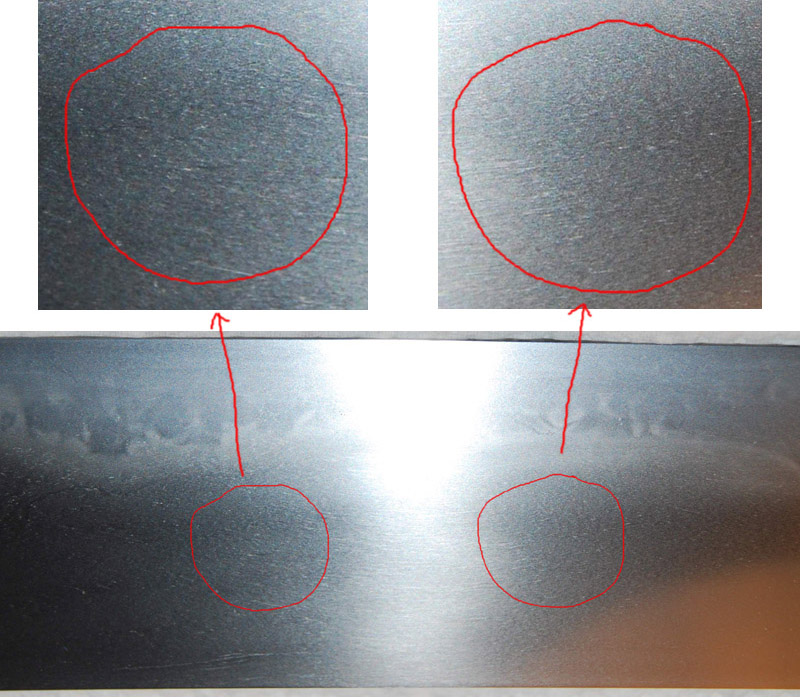
For examples;
Some of the good quality Hosho blades in Yamato province have a straight
layer pattern, but the CHIKEI appears like a small wood grain pattern.
The steel of Shintogo Kunimitsu's tanto has full of CHIKEI that is along
the small wood grain layer pattern. And his student Masamune's steel has
emphatic CHIKEI that appears along the large layer pattern.
In fact, we don't appreciate a chikei along the layer pattern too much.
Sometimes it is an appearance come from mix steel folding, either intentionally
or natural from uneven quality material.
Examples;
A steel of a Shintogo Knimitsu tanto.
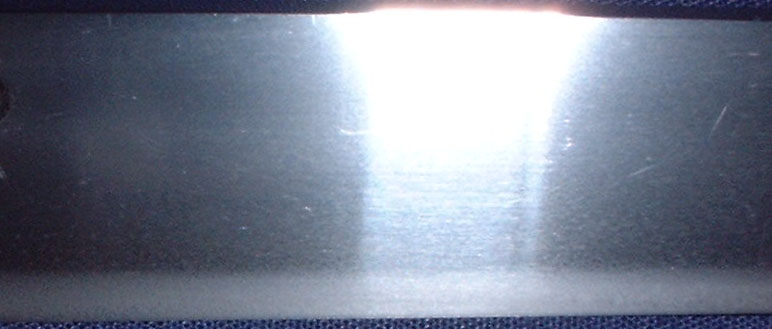
A steel of an Awataguchi Kuniyoshi tanto. It is full of fine chikei.
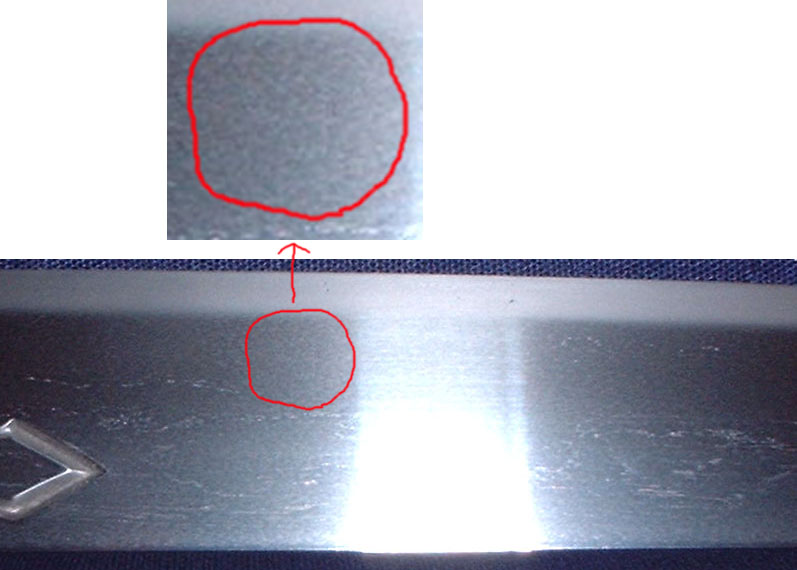
The next two photos are the same steel of modern blade, but in different
polishing. Please see the areas we marked. The first polish brings the
chikei (grain of steel particles), and the second polish brings the layer
pattern (straight pattern grain).
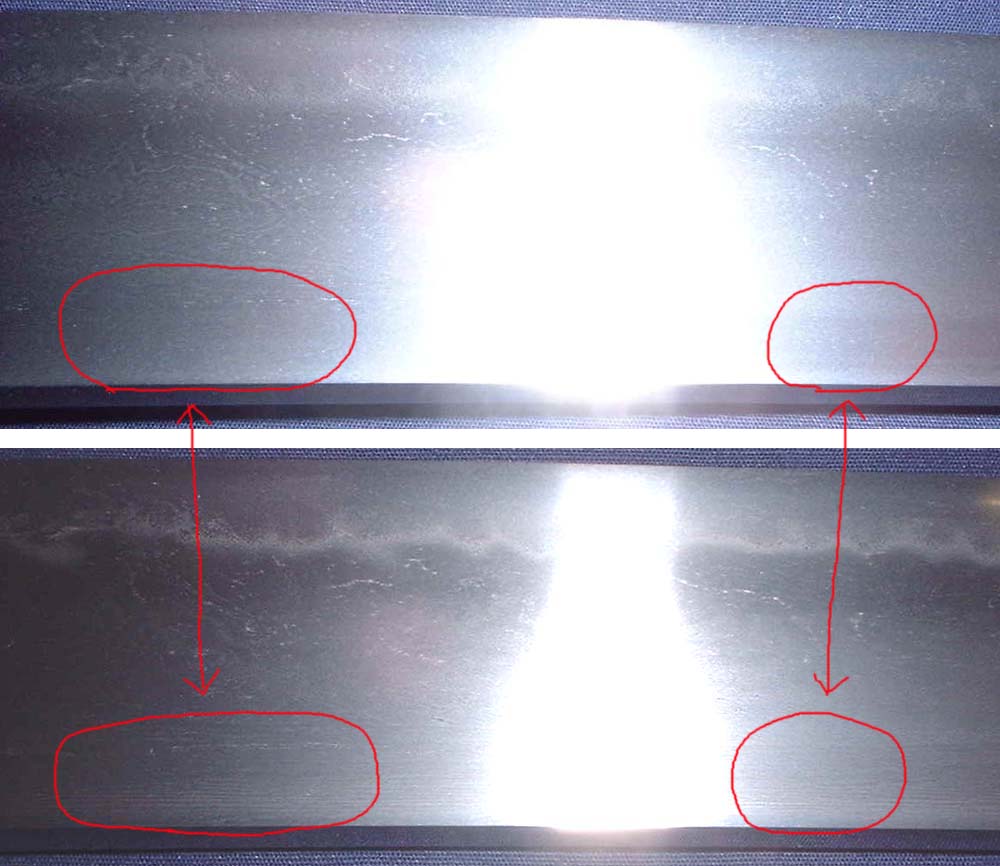
Another kind of chikei that runs along the layer pattern. It is a black
shining steel among the layer. It doesn't tend to be called chiki, but
recently such an apearance also be called chikei in the context of Art
sword.
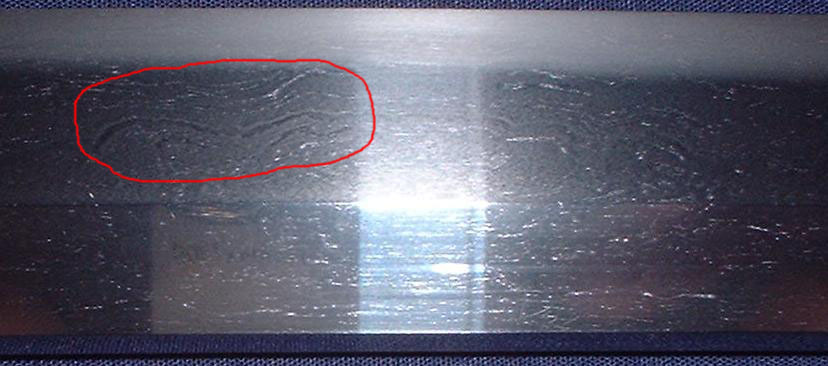
(=> Is the grain changed
by re-polishing?)
One more example
Yukihira in Bungo province in 12th century is famous for YAKIOTOSHI hamon.
Yakiotoshi is a hamon that starts at a distance from the tang.
On his blade, at the part below the mizukage, the steel has large flowing
wood grain pattern. And the upper part of the mizukage is a very small
fine wood grain pattern. But, by careful study, the layer pattern continues
the entire length of the blade.
The grain below the mizukage is an appears of the layer pattern, and the
grain of upper part is formed by steel particles.
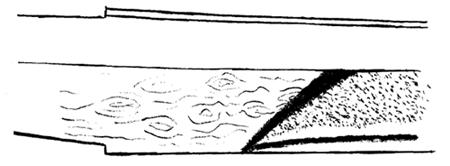
CHIKEI is one of the most interesting appearances of the steel of a Japanese
blade. To study CHIKEI is important to appreciate the quality of steel.
-Another way to use the word "CHIKEI"-
In some cases of mix folded steel, there is a CHIKEI like layer pattern
without JINIE effect. Sometimes it is also called CHIKEI, but such grain
is not a criterion of steel quality. CHIKEI has to be an array of steel
particles.
In the meaning of Art Sword, a running bright pattern
in steel is called Chikei anyhow.
An example of chikei-like pattern in Shin-shinto blade. It is made of mixing
with hard steel and mild steel. Such a chikei is designed by the smith
as an art.

JIFU
It is also one form of JINIE.
JIFU is an area that is made of dense CHIKEI, in other word the tightest
form of steel particles. It is distinguished from the steel surface. It
has a clear border and deeper colour than the other part. Of course it
appears free from the layer pattern. It is not bordered with a layer pattern.
The transformation steps of steel particles is: JINIE => CHIKEI =>
JIFU
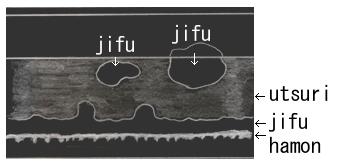
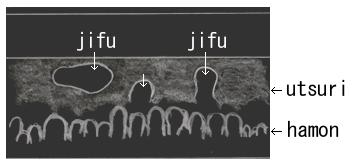
JIFU may appear only on good KOTO blades, but it still is rare. We appreciate
JIFU very much.
-Another way to use the word "JIFU"-
Sometimes a distinguishable spot that comes from different steel as material,
is also called JIFU by some people. But this type is not a criterion of
good quality. It is just an different steel. Such a spot is shaped with
the layer pattern. It does not come from the hardening effect.
In the meaning of Art Sword, a spotted appearance what is different from
the other surface is called Jifu, anyhow. So the word "Jifu"
could be used for a situation of core steel appearing.
An example of spotted steel (Namazu-hada, Sumi-hada, Sumi-gane) in Aoe
blade. It could be called Jifu by some people.
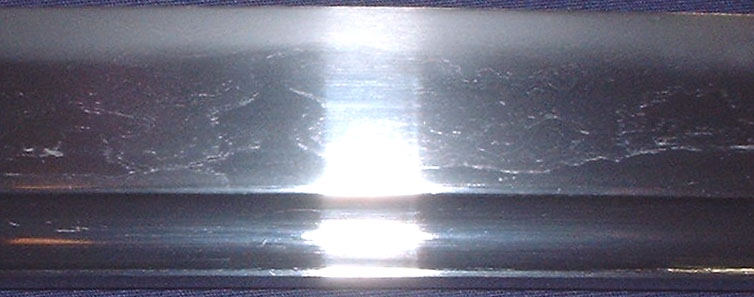
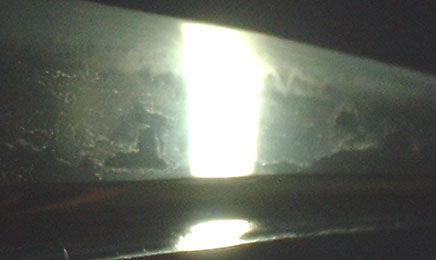
Home > Terms > Jinie, Chikei, Jifu








